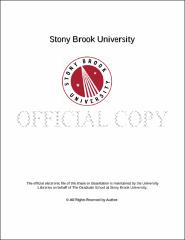| dc.identifier.uri | http://hdl.handle.net/11401/76751 | |
| dc.description.sponsorship | This work is sponsored by the Stony Brook University Graduate School in compliance with the requirements for completion of degree. | en_US |
| dc.format | Monograph | |
| dc.format.medium | Electronic Resource | en_US |
| dc.language.iso | en_US | |
| dc.publisher | The Graduate School, Stony Brook University: Stony Brook, NY. | |
| dc.type | Dissertation | |
| dcterms.abstract | The blood-brain barrier (BBB) is a multicellular integrative system that provides a protective interface between the circulatory system and the central nervous system (CNS), serving as a key regulator of neuronal function and physiological homeostasis. At the gliovascular interface, endothelial cells, astrocytes and pericytes are encased in a network of extracellular matrix (ECM) that forms a basal lamina (BL) comprised of ECM secreted by each cell type. Laminins are major constituents of the gliovascular BL where they bind dystroglycan, an adhesion receptor distributed along astrocytic endfeet and the abluminal membrane of endothelial cells. However, the contribution of laminin and dystroglycan to the development and function of the BBB remains unclear. To gain insight into how ECM interactions at the gliovascular interface contribute to BBB development we: (1) inactivated the LAMA2 gene to selectively eliminate laminin-211 from all cells of the developing brain, and (2) inactivated the DAG1 gene that encodes dystroglycan in neural lineage cells such as astrocytes and neurons. We identified laminin-211 and dystroglycan as novel regulators of the selective permeability of the BBB. We found that LAMA2 and DAG1 expression contribute to the acquisition of cerebrovascular pericyte coverage in the developing brain, functional tight junction morphology, adherens junction composition, and multiple aspects of gliovascular cell-cell and cell-ECM interactions, including glial endfeet architecture. Our findings suggest that laminin-dystroglycan interactions at the gliovascular interface regulate the maturation and function of the BBB. These findings also provide insight into the cellular and molecular changes that occur as a consequence of congenital muscular dystrophies caused by LAMA2 mutations or inappropriate dystroglycan post-translational modifications, which have accompanying brain abnormalities including seizures. Our results indicate a novel role for laminin-dystroglycan interactions in the cooperative integration of endothelial cells, astrocytes, and pericytes in regulating the BBB. | |
| dcterms.available | 2017-09-20T16:51:07Z | |
| dcterms.contributor | Colognato, Holly A | en_US |
| dcterms.contributor | Colognato, Holly | en_US |
| dcterms.contributor | El-Maghrabi, Raafat | en_US |
| dcterms.contributor | White, Thomas | en_US |
| dcterms.contributor | Tsirka, Styliani-Anna. | en_US |
| dcterms.creator | Menezes, Michael John | |
| dcterms.dateAccepted | 2017-09-20T16:51:07Z | |
| dcterms.dateSubmitted | 2017-09-20T16:51:07Z | |
| dcterms.description | Department of Physiology and Biophysics. | en_US |
| dcterms.extent | 153 pg. | en_US |
| dcterms.format | Application/PDF | en_US |
| dcterms.format | Monograph | |
| dcterms.identifier | http://hdl.handle.net/11401/76751 | |
| dcterms.issued | 2015-12-01 | |
| dcterms.language | en_US | |
| dcterms.provenance | Made available in DSpace on 2017-09-20T16:51:07Z (GMT). No. of bitstreams: 1
Menezes_grad.sunysb_0771E_12310.pdf: 3408666 bytes, checksum: 8ec9cbad248c67a0c977496999317e00 (MD5)
Previous issue date: 1 | en |
| dcterms.publisher | The Graduate School, Stony Brook University: Stony Brook, NY. | |
| dcterms.subject | Molecular biology | |
| dcterms.subject | astrocyte, Blood-brain barrier, Dystroglycan, Laminin, muscular dystrophy, pericyte | |
| dcterms.title | The Role of Laminin- Dystroglycan Interactions in the Development and Function of the Blood-Brain Barrier | |
| dcterms.type | Dissertation | |

